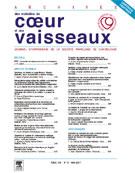02-16 - RIGHT VENTRICULAR SEPTAL PACING INDUCE SHORTER ELECTROMECHANICAL AND ELECTROSYSTOLIC INTRAVENTRICULAR DELAY THAN APICAL PACING IN PATIENTS WITHOUT LEFT VENTRICULAR DYSFUNCTION. - 09/04/08
JEGO [1],
Raphaël POYET [2],
Gilles CELLARIER [2],
Pierre LAURENT [2],
Christian BOUCHIAT [2],
Roland CARLIOZ [2]
Voir les affiliationsRight ventricular (RV) apical pacing (AP) induce widening of the QRS and dysynchrony (DS) of the left ventricle (LV), even without LV dysfunction. RV septal pacing (SP) is supposed to be more physiologic and to induce less DS. The aim of this study was to compare inter et intra ventricular DS due to RV AP and RV SP according to echocardiogram parameters in Tissue Doppler Imaging (TDI).
Methods: From 01.05 to 11.05, 30 consecutive patients (pts) (76 ± 9 years, 17 male, LVEF: 66.8 ± 5.9 %) with spontaneous underlying ventricular rhythm, who required pacing, were included. They were randomised in a ratio 1: 2 to receive RV AP or RV SP. The site of pacing was determined according to radiological and electrical criteria. One month after implantation, TDI DS was studied in spontaneous and paced rhythm: interV DS is defined as the delay between right and left output onset ; electromechanical (EM) and electrosystolic (ES) intraV DS are defined respectively as the maximal delay at the onset and at the peak of the systolic wave between 6 left basal ventricular walls: septal, lateral, anterior, inferior, anteroseptal and posterior. Electromechanical and ES DS was defined as a delay > 40 ms and > 65 ms respectively.
Results: Ten pts (77 ± 10 years, 5 male, LVEF: 68 ± 18 %) received RV AP and 20 (76 ± 7 years, 12 male, LVEF: 65 ± 13 %) RV SP. No difference was noted in implant duration, threshold, impedance and lead dislodgment between the 2 groups. Respectively for each group (AP/SP), spontaneous QRS and paced QRS duration were 92 ± 14 and 142 ± 55/103 ± 36 and 127 ± 37 ms, spontaneous and paced interV delay were 21 ± 17 and 21 ± 16/23 ± 15 and 21 ± 15 ms, spontaneous and paced EM intraV delay were 40 ± 19 and 44 ± 32/47 ± 36 and 37 ± 25 ms, spontaneous and paced ES delay were 54 ± 25 and 67 ± 30/67 ± 32 and 60 ± 35 ms. Between spontaneous and paced settings, RV AP induce significantly longer QRS (+50 ms vs +24 ms, p < = 0.05), EM intraV delay (+4 ms vs -10 ms, p < = 0.05) and ES intraV delay (+13 ms vs -7 ms, p < = 0.05) than RV SP. RV SP seems to be more efficient in pts with spontaneous wide QRS (> 120 ms) regarding TDI DS parameters. However, no difference occured in the interV delay.
Conclusion: In this study of pts without LV dysfunction requiring pacing, RV SP induce significantly narrower QRS and shorter EM and ES intraV delay than RV AP. Clinical significance of the consequences of this dysynchrony has to be studied for long term.
© 2007 Elsevier Masson SAS. Tous droits réservés.
Vol 100 - N° 12
P. 1074 - décembre 2007 Retour au numéroBienvenue sur EM-consulte, la référence des professionnels de santé.

